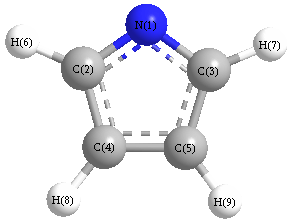Vibrational Frequencies calculated at CCSD(T)=FULL/TZVP
| Mode Number |
Symmetry |
Frequency
(cm-1) |
Scaled Frequency
(cm-1) |
IR Intensities
(km mol-1) |
Raman Act
(Å4/u) |
Dep P |
Dep U |
|---|
| 1 |
A1 |
3280 |
3136 |
|
|
|
|
| 2 |
A1 |
3238 |
3096 |
|
|
|
|
| 3 |
A1 |
1603 |
1533 |
|
|
|
|
| 4 |
A1 |
1496 |
1430 |
|
|
|
|
| 5 |
A1 |
1220 |
1167 |
|
|
|
|
| 6 |
A1 |
1139 |
1089 |
|
|
|
|
| 7 |
A1 |
1087 |
1039 |
|
|
|
|
| 8 |
A1 |
882 |
843 |
|
|
|
|
| 9 |
A2 |
755 |
722 |
|
|
|
|
| 10 |
A2 |
557 |
533 |
|
|
|
|
| 11 |
A2 |
219i |
210i |
|
|
|
|
| 12 |
B1 |
704 |
673 |
|
|
|
|
| 13 |
B1 |
641 |
613 |
|
|
|
|
| 14 |
B1 |
527 |
504 |
|
|
|
|
| 15 |
B2 |
3265 |
3121 |
|
|
|
|
| 16 |
B2 |
3233 |
3090 |
|
|
|
|
| 17 |
B2 |
1621 |
1550 |
|
|
|
|
| 18 |
B2 |
1357 |
1297 |
|
|
|
|
| 19 |
B2 |
1207 |
1154 |
|
|
|
|
| 20 |
B2 |
1078 |
1031 |
|
|
|
|
| 21 |
B2 |
833 |
796 |
|
|
|
|
Unscaled Zero Point Vibrational Energy (zpe) 14752.1 cm
-1
Scaled (by 0.956) Zero Point Vibrational Energy (zpe) 14103.0 cm
-1
See section
III.C.1 List or set vibrational scaling factors
to change the scale factors used here.
See section
III.C.2
Calculate a vibrational scaling factor for a given set of molecules
to determine the least squares best scaling factor.
